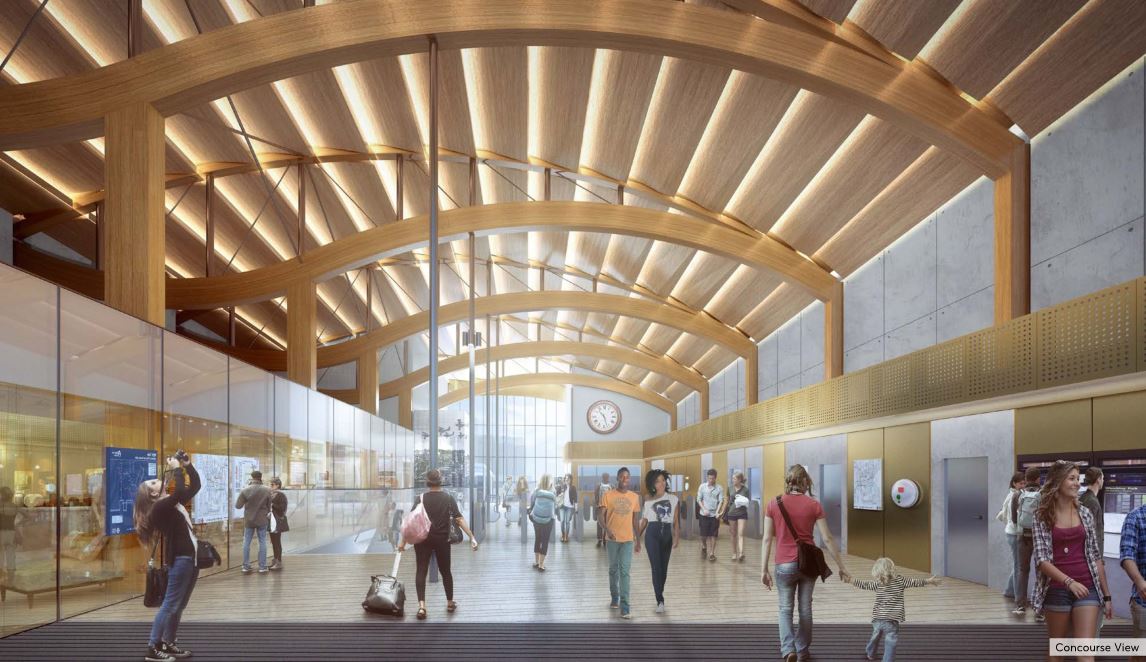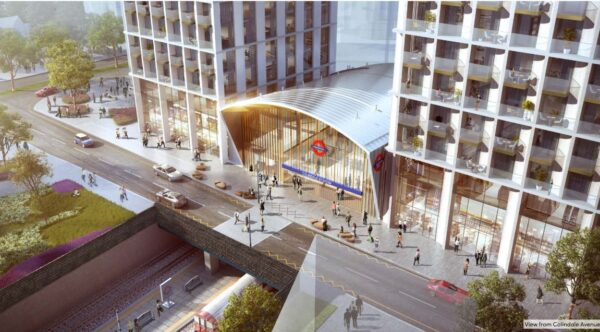A radical rebuild of Colindale tube station on the Northern line has been approved by Barnet Council.
The old “shed” of a ticket hall will be demolished, and completely new station building with an substantially enlarged ticket hall – around double the size of the existing space.
Although it will be surrounded on both sides by two tall towers, the station itself will be freestanding, and the design, by BDP of the curved wooden roofline takes its inspiration from early aircraft design at the nearby Hendon Aerodrome.
The station will be built on a new slab over the rail tracks, allowing for the existing bridge-parapet to be removed and the pavement in front of the station widened.
A total of £5 million in funding from TfL’s Growth Fund has been allocated for the new station building with step-free access and new pedestrian and cycle links. The project will cost in total some £22 million, so the remainder of the cost comes from the housing development.
The new ticket hall will come with nine ticket barriers (compared to 5 at the moment), and the introduction of step-free access to platform level with the provision of a new lift, which will sit between the two existing staircases down to the platform level.
The upgrade will also be good news for the nearby RAF Museum.
As well as the modernisation of Colindale Tube station, the proposals also include the creation of more than 300 new homes around the station site, of which half will be affordable housing.
Although planning is granted, TfL is currently reviewing the applications to build the development, so work on the new station is unlikely to start until 2021, with completion of the station rebuild in 2022.
The proposals are also subject to approval from the Mayor of London.
The station opened on 18 August 1924 on what was then the ‘Hampstead and Highgate Line’, the first station of the second section of the extension to Edgware. The station’s ticket hall was based on a classical style building designed by architect Stanley Heaps, who had previously been an assistant to Leslie Green.
At the time of its construction, Colindale was still largely open fields and the arrival of the railway spurred significant development in this part of north London. Badly damaged during WW2, the station was rebuilt in the mid-1960s but was in turn rebuilt in 2010, and redesigned again in 2015.
And now, it’s about to embark on its fourth stage in its life.












Given the Station location perhaps a facility for the nearby museum to display items to attract visitors might be included.
This scheme shows a way forward to make stations more accessible and perhaps overtrack development might be the way forward for shallow stations.
i think I might have caused this by the review I left on google reviews a year ago, obviously it was read by the right person.
One issue is, as stated in my review, if the station is put out of use whilst it is being worked on, that does that mean, every one has to walk to mill hill? I guess that will be the route?
See: https://www.google.com/search?source=hp&ei=gDs_XcyGMM-LlwS4g4OgCg&q=COL%3BINDALE+STATIOPN&oq=COL%3BINDALE+STATIOPN&gs_l=psy-ab.3..0i13l10.1982.8152..8527…1.0..0.72.1176.22……0….1..gws-wiz…..0..0i131j0j0i10.9qNopop6sEs&ved=0ahUKEwjMxsfN4drjAhXPxYUKHbjBAKQQ4dUDCAc&uact=5#lrd=0x4876113243919723:0x82438be10d477132,1,,,
A temporary station is being constructed with access to the rear of they stay club
What is the relevance of Mill Hill (East, I assume) to Colindale?? Totally different area of London and branch of the Northern Line…
@Chris Rogers – Mill Hill Broadway, more likely, which is a short bus ride from Colindale Station (at least, it’s a short bus ride from the RAF Museum, which is a short walk from Colindale – you can get a bus, but it goes round the houses and walking is arguably quicker, we found yesterday).
Thats a really wonderful idea about the display items imo, I really hope they do that , even suspending from ceiling (out of reach) a dedication to the amazing men and women that served not just this country but also helped to bring freedom to the known world, putting some thing in the lobby when the area is so connected to the war, the older generation (not many left now) if they got to see it would im sure really appreciate it and also anchor the station in the past and also a bridge to the future.
From time to time you hear really big heavy old ww2 bombers doing a loop or some thing near to the museum.
Well done London Underground, looks fantastic.
with the massive rebuilding of grahame park this station as it stands is not fit for purpose. making the booking hall bigger and adding extra gates is at least a way forward.
No point increasing the capacity of the station and adding lots of buildings full of people to use the station if the capacity of the trains doesn’t increase too.
Equally no point increasing capacity on the trains if the stations remain a bottleneck that wont handle the capacity.
Increasing station capacity is part of the same package as increasing train capacity. It’s not an either/or situation.
With the RAF Museum being already noted as being relatively nearby, it is a shame that separate plans exist to withdraw permanently the bus service to it, and to reroute it via other parts of the Graham Park site instead. For a fit person it is not too far to walk but for anyone with walking difficulties this seems a big shame.
It is a pity, but in fact it’s only about a 6-7 minute walk from Colindale Tube, and presumably the bus will still go to and from Mill Hill Broadway for those who can’t manage that far. I was surprised at what an easy walk it was – and I don’t find walking any distance any too easy these days.
Filter the road outside so it can just be used as a through route by buses, emergency vehicle, cycles and pedestrians. Lots of cycle routes and parking required when all those flats are built. Barnet bans cycling in its parks which is a disgrace!
looks very nice on the concourse but why is there a Piccadilly line train there?
What’s the point of a bigger station and easier access? Unless there is major improvement to the line with much more frequent trains your only going to get much more congestion on the already congested platforms!! And 300 more homes? With no parking facilities? Colindale for those of us who live here is already bursting at the seams! We’ve seen no more schools and GP practices are full. I like the look of the new station but as for 300 new homes! And Colindale Gardens is when complete going to add thousand more people to the area!! Terrible idea with No real consideration.
You can’t run more trains more often unless you expand the capacity of the stations to cope with the larger crowds first.